

To trace
the history of the University of Iowa Herbarium
is to trace the establishment and development of the Biological Sciences and
the Museum of Natural History at this University. Leading university figures,
scientists of national and international reputation, including Charles A. White,
Thomas Huston Macbride and Bohumil Shimek, and in later years, George W. Martin,
Henry S. Conard and Robert F. Thorne, contributed to the development of an irreplaceable
collection that embodied not only the natural history of Iowa, but that of other
regions of North America, from Nicaragua and Mexico to Louisiana and Florida,
Ontario (Canada), Colorado, Washington and California, as well other parts of
the world, including Europe, New Zealand and Fiji.
Robert Thorne (1951) suggested that the Herbarium
was established "about 1870" by Thomas Huston Macbride, yet his statement is
curious because Macbride did not join the University until 1878. Recently discovered
evidence reveals that Thorne's date is nearly accurate, but establishment of
the collection predates Macbride. In 1996, Jennifer Bell (then Assistant Curator)
investigated the 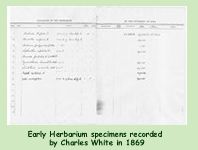 history
of a worn, folio, hard-bound (leather and canvas), two-inch thick ledger containing
pages printed "Catalogue
of the Herbarium of the University of Iowa". The only entries, nine
species of vascular plants, were collected at three localities, all within a
mile or two of Iowa City, by "C.A. White" between August 1st and September 7th
of 1869. The plants, all except two of which are mints, represent an eclectic
mixture of native prairie and woodland species, as well as at least one alien
species. Ms. Bell made the connection to Charles
A. White (1826-1910), a geologist at the
history
of a worn, folio, hard-bound (leather and canvas), two-inch thick ledger containing
pages printed "Catalogue
of the Herbarium of the University of Iowa". The only entries, nine
species of vascular plants, were collected at three localities, all within a
mile or two of Iowa City, by "C.A. White" between August 1st and September 7th
of 1869. The plants, all except two of which are mints, represent an eclectic
mixture of native prairie and woodland species, as well as at least one alien
species. Ms. Bell made the connection to Charles
A. White (1826-1910), a geologist at the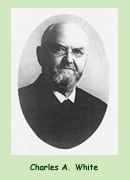 University from 1867 to 1873, thus establishing that the University of Iowa
Herbarium had been founded by 1869, if not earlier, and making it the first
Herbarium in Iowa. Regrettably, the specimens enumerated by White no longer
are in the collection.
University from 1867 to 1873, thus establishing that the University of Iowa
Herbarium had been founded by 1869, if not earlier, and making it the first
Herbarium in Iowa. Regrettably, the specimens enumerated by White no longer
are in the collection.
Ms. Bell's research in the University of Iowa Libraries, Special Collections
also established that, from the beginning, the Herbarium was an integral part
of the Museum of Natural History. In 1858, the Iowa General Assembly directed
the establishment of a 'Cabinet' of natural history in the Old Capitol, to house
specimens collected by the State Geologist (Schrimper 1992). Later, the Cabinet
would become known as the Museum of Natural History, the second oldest such
museum west of the Mississippi (Schrimper 1992). James Hall, State Geologist
and Professor of Natural History, was appointed the first Curator of the Cabinet
of Natural History in 1858, and Theodore S. Parvin succeeded him in 1859 as
Professor of Natural History and Curator (Schrimper 1992). The Record of the
Board of Trustees from February 3, 1859 documents that in 1858, the sum of one
thousand dollars was "appropriated to the fitting up of the East half of
the old Senate Chamber as a Cabinet" (the northeast corner of the second
floor). In the 1867-68 Catalogue of the University, Charles A. White (1826-1910)
is identified as Professor of Geology, although in an 1870 report to the Board
of Regents, he signs himself "Prof. of Geology, Zoology & Botany".
Also, the description of 'The Cabinet' in the 1867-68 Catalogue similarly refers
to him indirectly by the latter title and makes it clear that the Cabinet comprised
botanical and zoological, as well as geological, specimens.
|
"Geology
&c.-The Cabinet.
|
| The
collections now contained in the University Cabinet are sufficient to illustrate
very fully the studies pertaining to the Chair of Geology, Zoology and Botany,
and additions are constantly being made. The large collection of fossils
and minerals obtained from the State Geological Survey afford unusual facilities
for studying general Geology, and especially that of the State of Iowa.
The State Geologist being Professor of Geology in the University will give
especial attention to the Geology of Iowa in the course of instruction. Toward the close of the Spring Term the Professor of Geology, Zoology and Botany will accompany his classes in frequent excursions to the field for purposes of instruction and collecting specimens." |
In his
1870 report to the Board of Regents, White recorded the number of students he
had taught over the past university year, including 14 in Elementary Science,
59 in Physiology, 28 in Zoology, 22 in Geology and 72 in Botany, and he expressed
concern because he had been obliged to "teach in the Cabinet room where
all the valuable collections, instruments &c. are kept", because no
classroom had been assigned to him. He also noted, "I have never before
known the cabinet room of any institution to be used for any other than for
cabinet purposes, and it never should be". White's report concludes with
a lengthy list of "immediate wants", including "A good quantity
of proper kinds of paper for collecting and preserving plants for the herbarium".
In 1871, White succeeded Parvin as Curator of the Cabinet of Natural History
(Schrimper 1992), and in the April 1871 issue of The
University Reporter, there is the first of a series of articles by White,
"Natural History - How to Collect and Preserve  Specimens",
that included instructions for collecting and preserving specimens of plants
and insects. He described how
to press plants using folded sheets of "unprinted newspaper" (designated
'plant papers') interleaved between "a quantity of old newspapers" ('dryers'),
and noted that the dryers and plant papers should be alternated between "strong
inch board" ('press boards') and placed under "any kind of weight…from fifty
to a hundred pounds". White's association with the University of Iowa was relatively
brief; in 1873, he left for Bowdoin College in Brunswick, Maine (Schrimper 1992).
Before he left, White submitted to the Board of Regents a report, which is largely
an enumeration of specimens in the Cabinet, and noted "I have devoted all
the time I could spare from my classes to the labelling and naming of these
collections with a view to preparing a well arranged catalogue of them, but
as I have no assistance of any kind this will require a long time". There
are two lists of specimens: those that were in the collection prior to his arrival
at the University in 1867 (7 items), and those obtained since, a list of 20
items, number 14 of which is "Plants, collected on the Geological Survey,
and placed in the herbarium case in the cabinet room". Clearly, it was
Charles White who established the University of Iowa Herbarium and it may have
been in existence as early as 1867. However, it is two of White's successors,
Thomas Huston Macbride and Bohumil Shimek, who were the dominant figures in
the early development of the Herbarium.
Specimens",
that included instructions for collecting and preserving specimens of plants
and insects. He described how
to press plants using folded sheets of "unprinted newspaper" (designated
'plant papers') interleaved between "a quantity of old newspapers" ('dryers'),
and noted that the dryers and plant papers should be alternated between "strong
inch board" ('press boards') and placed under "any kind of weight…from fifty
to a hundred pounds". White's association with the University of Iowa was relatively
brief; in 1873, he left for Bowdoin College in Brunswick, Maine (Schrimper 1992).
Before he left, White submitted to the Board of Regents a report, which is largely
an enumeration of specimens in the Cabinet, and noted "I have devoted all
the time I could spare from my classes to the labelling and naming of these
collections with a view to preparing a well arranged catalogue of them, but
as I have no assistance of any kind this will require a long time". There
are two lists of specimens: those that were in the collection prior to his arrival
at the University in 1867 (7 items), and those obtained since, a list of 20
items, number 14 of which is "Plants, collected on the Geological Survey,
and placed in the herbarium case in the cabinet room". Clearly, it was
Charles White who established the University of Iowa Herbarium and it may have
been in existence as early as 1867. However, it is two of White's successors,
Thomas Huston Macbride and Bohumil Shimek, who were the dominant figures in
the early development of the Herbarium.
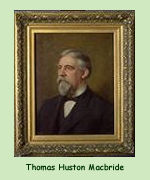 Thomas
Huston Macbride (1848-1934) was born in Rogersville, Tennessee,
the son of a Presbyterian minister (Shimek 1934). His family left Tennessee
and came to Iowa before the Civil War because of his father's
"strong abolition sentiments" (Shimek 1934). They moved around in
eastern Iowa, eventually settling in Princeton, Scott County (Shimek 1934).
In 1864, he was a mathematics student of Samuel Calvin at Lenox College (Calvin
1908) in Hopkinton, Iowa, and in 1869 and 1873, he received bachelor's and master's
(respectively) degrees in art from Monmouth College in Illinois (Shimek 1934).
Macbride began his career in 1870 as a professor of mathematics and languages
at Lenox College in Hopkinton, Iowa, when he replaced Calvin (Shimek 1934).
In 1873, Calvin replaced Charles White as Professor of Natural Science and Curator
of the Cabinet of Natural History (Schrimper 1992), and he later recounted how
he and Macbride, who had become friends while Macbride was his student, had
begun going on field trips together in the early 70s "for the purpose of extending
our knowledge of the geology and botany of the state and supplementing the inadequate
college courses offered in these subjects at the time" (Calvin 1908). In 1878,
the Botany Department was established when Macbride was hired as Assistant Professor
of Natural Science and in Charge of Botany (Minutes of the Board of Regents
1878 cf. Conklin 1945) to Calvin. The telegram from Calvin to Macbride,
dated June 18, 1878, is in Special Collections. It reads: "Will you accept
a position as adjunct Professor of Natural Science at twelve hundred dollars
per year if elected. Answer. S. Calvin. 20 Paid". A specimen of Waterpod
or Wild Tomato (Ellisia nyctelea L.) collected by Macbride in 1877 in
Delaware Co. might have been the earliest Iowa specimen in the Herbarium, and
it documents that Macbride was collecting specimens prior to being hired by
the University. By 1880, approximately 300 specimens representing 100 species
of the local flora had been deposited in the Herbarium (Conklin 1945).
Thomas
Huston Macbride (1848-1934) was born in Rogersville, Tennessee,
the son of a Presbyterian minister (Shimek 1934). His family left Tennessee
and came to Iowa before the Civil War because of his father's
"strong abolition sentiments" (Shimek 1934). They moved around in
eastern Iowa, eventually settling in Princeton, Scott County (Shimek 1934).
In 1864, he was a mathematics student of Samuel Calvin at Lenox College (Calvin
1908) in Hopkinton, Iowa, and in 1869 and 1873, he received bachelor's and master's
(respectively) degrees in art from Monmouth College in Illinois (Shimek 1934).
Macbride began his career in 1870 as a professor of mathematics and languages
at Lenox College in Hopkinton, Iowa, when he replaced Calvin (Shimek 1934).
In 1873, Calvin replaced Charles White as Professor of Natural Science and Curator
of the Cabinet of Natural History (Schrimper 1992), and he later recounted how
he and Macbride, who had become friends while Macbride was his student, had
begun going on field trips together in the early 70s "for the purpose of extending
our knowledge of the geology and botany of the state and supplementing the inadequate
college courses offered in these subjects at the time" (Calvin 1908). In 1878,
the Botany Department was established when Macbride was hired as Assistant Professor
of Natural Science and in Charge of Botany (Minutes of the Board of Regents
1878 cf. Conklin 1945) to Calvin. The telegram from Calvin to Macbride,
dated June 18, 1878, is in Special Collections. It reads: "Will you accept
a position as adjunct Professor of Natural Science at twelve hundred dollars
per year if elected. Answer. S. Calvin. 20 Paid". A specimen of Waterpod
or Wild Tomato (Ellisia nyctelea L.) collected by Macbride in 1877 in
Delaware Co. might have been the earliest Iowa specimen in the Herbarium, and
it documents that Macbride was collecting specimens prior to being hired by
the University. By 1880, approximately 300 specimens representing 100 species
of the local flora had been deposited in the Herbarium (Conklin 1945).
While the early focus of the Herbarium was Iowa vascular plants and Macbride's
specimens of these number approximately 500, most of which were collected prior
to 1900 (cf. Thorne 1952, Herbarium records), Macbride also ensured that
the collection would have both geographic and taxonomic breadth. In 1893, the
Herbarium was the recipient of "a large set of duplicates from the British Museum,
embracing thousands of sheets from various parts of the world" (Macbride 1912).
These included collections made by E. Fries, Hooker, Kerner, Lagerheim, Rugel,
W. Schimper, Shuttleworth, Tenore and Welwitsch, most of which are from Europe,
but also included were collections from Labrador and Greenland, Iceland, Lapland
and Kamchatka, the Azores, Canary Islands, Algeria, Abyssinia, Arabia and India
(Thorne 1951). In a letter of May 3, 1893, the curator of British Museum expressed
delight with the "beautiful specimens" of myxomycetes that Macbride
had sent, and documents that 30,000 specimens in seven cases "have just
been delivered to the shipper". Macbride later referred to the British
Museum specimens as a 'gift' (Macbride 1912); however, it is clear they were
acquired as an exchange, possibly the first from the Herbarium.
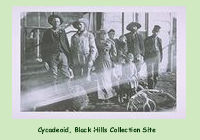 Also
in 1893, Macbride was in Hot Springs, South Dakota where he saw a "magnificently
preserved fossil Cycad"
Also
in 1893, Macbride was in Hot Springs, South Dakota where he saw a "magnificently
preserved fossil Cycad" 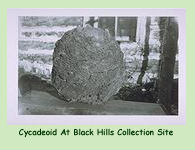 (actually,
a cycadeoid) for sale (M'Bride 1894). These fascinating fossils are Cretaceous
in age (145-65 my BP - million years before present) and local people thought
they were fossil beehives (Raventon 1994), for obvious reasons, considering
the shape of the fossilized trunks.
(actually,
a cycadeoid) for sale (M'Bride 1894). These fascinating fossils are Cretaceous
in age (145-65 my BP - million years before present) and local people thought
they were fossil beehives (Raventon 1994), for obvious reasons, considering
the shape of the fossilized trunks. 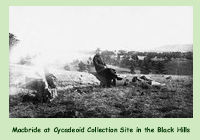 Macbride
related that about thirty additional cycadeoid specimens were found "on a bare
hill" (M'Bride 1894), and he brought back 24, which became the first fossil
collections in the Herbarium. Later, two of these were designated type specimens
(specimens that are the physical documentation for the original
Macbride
related that about thirty additional cycadeoid specimens were found "on a bare
hill" (M'Bride 1894), and he brought back 24, which became the first fossil
collections in the Herbarium. Later, two of these were designated type specimens
(specimens that are the physical documentation for the original description of a species) for two species, Bennettites dacotensis Macbride
and Cycadeoidea mcbridei Ward, the former described by him and the latter
named in honour of him (Hartwig 1976). Macbride published on the Black Hills
cycadeoids in the American Geologist in 1893 and this well may have provided
the impetus for a 'cycad rush' (Raventon 1994) to the Black Hills. By 1906,
over 700 specimens had gone to Yale University (Hartwig 1976). It is noteworthy
that while Macbride was in the Black Hills, he did not limit his activities
to collections of fossil plants, but used it as an opportunity to expand the
Herbarium's geographic representation of vascular plants as well. In a letter
to his wife, written in Hot Springs, South Dakota on August 7th, 1893, he related
"I am picking up a good many flowers and pressing them".
description of a species) for two species, Bennettites dacotensis Macbride
and Cycadeoidea mcbridei Ward, the former described by him and the latter
named in honour of him (Hartwig 1976). Macbride published on the Black Hills
cycadeoids in the American Geologist in 1893 and this well may have provided
the impetus for a 'cycad rush' (Raventon 1994) to the Black Hills. By 1906,
over 700 specimens had gone to Yale University (Hartwig 1976). It is noteworthy
that while Macbride was in the Black Hills, he did not limit his activities
to collections of fossil plants, but used it as an opportunity to expand the
Herbarium's geographic representation of vascular plants as well. In a letter
to his wife, written in Hot Springs, South Dakota on August 7th, 1893, he related
"I am picking up a good many flowers and pressing them".
The taxonomic breadth of the collections was further enhanced because Macbride's
primary interest was neither vascular plants nor fossils, but fungi and particularly
slime molds, and he became a world authority on the latter (Shimek 1934). Over
30 of his publications dealt with slime molds and fungi, including a monograph
of The North American Slime-moulds [sic], the first edition of which
was published in 1899 (Shimek 1934). A second, revised and enlarged edition
was published in 1922, and a third, revised edition (with George W. Martin),
The Myxomycetes, was published in 1934 (Shimek 1934), the year that he died.
Naturally, Macbride's taxonomic research on slime molds and fungi led to development
of extensive collections of both groups of organisms. Macbride (1912) recounted
that the Herbarium acquired the slime mold collections of Wingate in 1898 and
later of Peck. Also, in 1909, the "magnificent herbarium, chiefly mycologic"
of A.P. Morgan of Ohio was a gift from Mrs. Morgan (Macbride 1912). Macbride
concluded that "the entire mycologic property of the University certainly
[is] as rich as any on this continent" (Macbride 1912).
Collections of bryophytes (mosses and hepatics) also were being accumulated
under Macbride's direction. 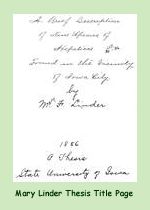 In
1996, Jennifer Bell discovered in Special Collections, an 1886 thesis by Mary
F. Linder. Ms. Bell linked it to the Herbarium because the title
is "A Brief Description of Nine Species of Hepaticae Found in the Vicinity of
Iowa City". This Master's Thesis is the first post-graduate thesis completed
at the University of Iowa and it predates formation of the Graduate College
in 1900 (David McCartney, University Archivist, in litt. 2002). Given
the subject matter and the date, it seems reasonable to assume that Macbride
was Mary Linder's supervisor (Bohumil Shimek was not hired until 1890). Macbride
evidently had some knowledge of bryophytes, since he published a report on a
moss found in a peat deposit (see Macbride 1896a).
In
1996, Jennifer Bell discovered in Special Collections, an 1886 thesis by Mary
F. Linder. Ms. Bell linked it to the Herbarium because the title
is "A Brief Description of Nine Species of Hepaticae Found in the Vicinity of
Iowa City". This Master's Thesis is the first post-graduate thesis completed
at the University of Iowa and it predates formation of the Graduate College
in 1900 (David McCartney, University Archivist, in litt. 2002). Given
the subject matter and the date, it seems reasonable to assume that Macbride
was Mary Linder's supervisor (Bohumil Shimek was not hired until 1890). Macbride
evidently had some knowledge of bryophytes, since he published a report on a
moss found in a peat deposit (see Macbride 1896a).
Mary Linder's thesis is comprised of 66 pages of handwritten text and 21
plates of pencil line-drawings. 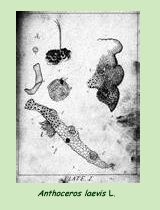 There
are descriptions and illustrations of Anthoceros laevis L., Marchantia
polymorpha L., Conocephalum conicum L. (as Conocephalus conicus),
Reboulia hemispherica (L.) Raddi (as Asterella hemispherica),
Porella platyphylla (L.) Pfeiff. (as Madotheca platyphylla), probably
Frullania inflata Gottsche (as Lejeunia
There
are descriptions and illustrations of Anthoceros laevis L., Marchantia
polymorpha L., Conocephalum conicum L. (as Conocephalus conicus),
Reboulia hemispherica (L.) Raddi (as Asterella hemispherica),
Porella platyphylla (L.) Pfeiff. (as Madotheca platyphylla), probably
Frullania inflata Gottsche (as Lejeunia 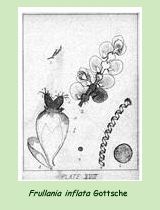 serphyllifolia),
Lophocolea heterophylla (Schrad.) Dumort., what appears to be Lophocolea
minor Nees (as Jungermannia ventricosa), and what might be Plagiochila
asplenioides (L.) Dumort. (the latter is represented by unidentified illustrations).
The descriptions and detailed illustrations of the plants, as well as the discussion
of habitat for some, reflect a noteworthy level of understanding of details
of the morphology of this difficult group of plants. Interestingly, Linder's
thesis is not quite complete. Pages 61, 63 and 64 are blank, except for the
page number at the top of the page, while
serphyllifolia),
Lophocolea heterophylla (Schrad.) Dumort., what appears to be Lophocolea
minor Nees (as Jungermannia ventricosa), and what might be Plagiochila
asplenioides (L.) Dumort. (the latter is represented by unidentified illustrations).
The descriptions and detailed illustrations of the plants, as well as the discussion
of habitat for some, reflect a noteworthy level of understanding of details
of the morphology of this difficult group of plants. Interestingly, Linder's
thesis is not quite complete. Pages 61, 63 and 64 are blank, except for the
page number at the top of the page, while  on
page 62, there is a description of the habitat and general appearance in the
field of the species that might be P. asplenioides. Also, on page 65,
the species treated in the thesis are enumerated and eight, rather than nine,
are listed. Regrettably, there were no Linder specimens of these species in
the Herbarium, but there were over 30 of her specimens
on
page 62, there is a description of the habitat and general appearance in the
field of the species that might be P. asplenioides. Also, on page 65,
the species treated in the thesis are enumerated and eight, rather than nine,
are listed. Regrettably, there were no Linder specimens of these species in
the Herbarium, but there were over 30 of her specimens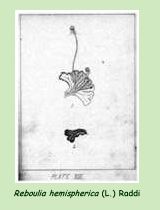 of vascular plants collected in Iowa City and Johnson County. Many are undated,
but the earliest dated collection is from 1885 and the rest are from 1889. Her
specimens document some rare/uncommon species, including Grass of Parnassus
(Parnassia glauca Raf.), Nodding Pogonia (Triphora tranthophora
(Sw.) Rydb.), Putty-root Orchid (Aplectrum hyemale (Muhl. ex Willd.)
Torrey from Iowa City, Sessile-leaved Bellwort (Uvularia sessilifolia
L.), and One-flowered Cancer-root (Orobanche uniflora L., as Aphyllon
uniflora) from Iowa City. The specimen of Grass of Parnassus was the only
Herbarium record from Johnson County and the One-flowered Cancer-root was one
of two Johnson County records for this rare species (the other, a Shimek specimen,
also was collected in Iowa City in 1927).
of vascular plants collected in Iowa City and Johnson County. Many are undated,
but the earliest dated collection is from 1885 and the rest are from 1889. Her
specimens document some rare/uncommon species, including Grass of Parnassus
(Parnassia glauca Raf.), Nodding Pogonia (Triphora tranthophora
(Sw.) Rydb.), Putty-root Orchid (Aplectrum hyemale (Muhl. ex Willd.)
Torrey from Iowa City, Sessile-leaved Bellwort (Uvularia sessilifolia
L.), and One-flowered Cancer-root (Orobanche uniflora L., as Aphyllon
uniflora) from Iowa City. The specimen of Grass of Parnassus was the only
Herbarium record from Johnson County and the One-flowered Cancer-root was one
of two Johnson County records for this rare species (the other, a Shimek specimen,
also was collected in Iowa City in 1927).
Coincidentally, in late 2001, the Herbarium was given some boxes of specimens
found by a workman when an Iowa City house that belonged to the Linder family
was cleaned out. These specimens were of mosses, fungi and lichens, and most
of them were sets of specimens termed exsiccatae. An exsiccata is comprised
of multiple, identical sets of serially numbered specimens, usually with printed
labels (Sayre 1969), collected by one or a few persons and generally representative
of the flora of a particular geographic region. Such sets were distributed by
exchange, sale or gift (see Sayre 1969). Some of Holzinger's Musci Acrocarpi
Boreali-Americani (Holzinger 1904-1929) were among the specimens from the Linder
home. Many still were in the wrappers in which they were mailed, and intriguingly,
they were addressed to Professor T. J. Fitzpatrick at an Iowa City post office
box or, in a few cases, at the State Historical Society, in the early 1900s,
according to the cancellation dates on some of the stamps. The Fitzpatricks
(husband and wife) were well-known botanists from Lamoni, Iowa, whose main focus
was vascular plants. In 1912, Macbride remarked that they had "perhaps an almost
complete collection of the flowering plants of Iowa", but also noted that they
had significant collections of "fungi with other cryptogamic plants" (Macbride
1912). It seems likely that these specimens were in the Linder family home because
they were in Mary Linder's possession, possibly a gift from the Fitzpatricks.
Macbride's contributions to science, the university and the state were many
and varied. His scholarly scientific contributions were mainly in the area of
mycology; in particular, he was 'the' authority on myxomycetes for North America
for at least 30 years. He established Botany as a formal discipline at this
University, and he developed the Herbarium into a significant collection with
wide taxonomic and geographic representation. Macbride enjoyed a highly successful
academic career at this University. In 1883, five years after he was hired as
an Assistant Professor of Natural History, he was appointed Professor of Botany
and Systematic Zoology; from 1902 to 1913, he was Botany Department Head; and
from 1913 to 1916, he was University President (dates and ranks from the card
catalogue, University of Iowa Libraries, Special Collections). In 1909, Macbride,
with Samuel Calvin and Bohumil Shimek, founded Iowa Lakeside Laboratory, the
University's (at that time) biological station on West Okoboji Lake (Zieglowsky
1985). Underlying everything that he did, Macbride was a conservationist. When
returning from a trip east in 1879, he wrote to his wife, "Ohio is cultivated
to the extermination of all nature. The crops are fine and Republican chances
good in consequence. I enjoy very much the peaceful valleys and wood crowned
hills. The great forests of course are all gone here but here and there a grove
of native trees tells of departed glory" (August 10, 1879). In his presidential
address to the Iowa Academy of Science in 1897 (Macbride 1898), Macbride expressed
concern over the drainage of wetlands, in part from the practical perspective
that this would reduce the amount of water in the rivers and streams, the only
source of water for many Iowa cities. He also pointed out the aesthetic appeal
and inestimable value of natural habitats, and warned that "The drainage
of our prairies, the destruction of what little woods we have, these two things
do, in my judgment threaten our wealth...". Shimek (1934) described Macbride
as the "father of...conservation in Iowa", and Roosa (1981) suggested
that Macbride may have been the "most influential individual in sensing
the need for resource protection and in setting in motion machinery toward that
end" and concluded that "It was his article on county parks (1895
[Macbride 1896b]) that led to the establishment of the system of state parks
we have today".
Macbride's name has been the source of some confusion. Shimek (1934) noted that
Macbride initially spelled his name 'McBride' (also rendered M'Bride in some
early publications; see the discussion of cycadeoids above), but later altered
it to the original Scottish form, 'Macbride', with a small 'b'. This is well
known by anyone with connections to the University of Iowa, since his name graces
one of the four buildings surrounding the Old Capitol. What may have been overlooked
is that Macbride went by the name of 'Huston', not 'Thomas'. This has been obscured
because, with formality customary for the time, most people referred to him
either as Professor Macbride or Thomas Huston Macbride. However, Calvin (1908)
recalled meeting a student "named Huston Macbride", and in many of
her letters, his wife similarly addressed him as Huston.
By all reports, Macbride was an exceptional individual, personally as well as
professionally. In an official tribute to Macbride, celebrating "Thirty
Years in the State University", Samuel Calvin (1908) described the young
student in his mathematics class: "an active, restless little fellow, but
bright and manly and lovable; bubbling over with the best of humor and good
nature, but taking hold of his class work in the most serious and successful
manner". In his obituary of Macbride, Shimek (1934) described him as "An
eminent scientist, a profound scholar, an inspiring teacher, a brilliant public
speaker, a public-spirited citizen, a lover of the beautiful in everything material
as well as moral and ethical, a man of high character and a true friend".
The University of Iowa Libraries, Special Collections has a treasuretrove of
Macbride correspondence, mainly between Macbride and his wife, 'Hattie' (Harriet
Diefendorfer), whom he met when she was his student at Lenox College and later
married in 1875 (Shimek 1934). These letters give a real sense of the person
Macbride was, and they only enhance one's perceptions of this man. It is apparent
that Hattie and Huston shared an unusually devoted relationship, and also that
Macbride was an exceptionally kind and loving father to their two children,
Jean and Philip. They also reveal a gentle sense of humour. In most letters
to the family, he addressed them to Hattie, Jean and Philip, with the children
in order of birth, but in one, he put Philip's name before Jean's and commented
that he put Philip in the middle to keep him warm because it was an unusually
cold night out.
 Bohumil
Shimek (1861-1937) was born on
a farm near Shueyville, Johnson County, Iowa (Kay 1939) to Czech parents, who
came to the United States to escape religious and political persecution under
the Austrian empire (Loehwing 1937). They moved to Iowa City in 1866 to have
access to medical facilities for his mother, who died of tuberculosis shortly
afterwards (Conard 1945-46). Shimek's father worked as a cobbler out of his
home, but he became paralyzed in 1878, when Shimek was 17, and died in 1880
(Conard 1945-46). Conard (1945-46) recorded that Shimek was "partly self supporting
at eleven…and wholly so at sixteen", and he supported himself "through school
and college largely as collector for the Botany, Taxidermy, and Zoology classes
at the State University of Iowa". In 1883, Shimek graduated from the University
with a degree in civil engineering, and subsequently worked as a railroad
and county surveyor
Bohumil
Shimek (1861-1937) was born on
a farm near Shueyville, Johnson County, Iowa (Kay 1939) to Czech parents, who
came to the United States to escape religious and political persecution under
the Austrian empire (Loehwing 1937). They moved to Iowa City in 1866 to have
access to medical facilities for his mother, who died of tuberculosis shortly
afterwards (Conard 1945-46). Shimek's father worked as a cobbler out of his
home, but he became paralyzed in 1878, when Shimek was 17, and died in 1880
(Conard 1945-46). Conard (1945-46) recorded that Shimek was "partly self supporting
at eleven…and wholly so at sixteen", and he supported himself "through school
and college largely as collector for the Botany, Taxidermy, and Zoology classes
at the State University of Iowa". In 1883, Shimek graduated from the University
with a degree in civil engineering, and subsequently worked as a railroad
and county surveyor (Loehwing 1937). He was an instructor of Zoology at the University of Nebraska
from 1888 to 1890, when he returned to the University of Iowa as an Instructor
in Botany (Loehwing 1937). In 1895, he became Assistant Professor in Botany
and Curator of the Herbarium, and he continued in the latter position until
his death (card catalogue, University of Iowa Libraries, Special Collections).
Shimek was awarded a Master's in Science from the University in 1902 (Conard
1945-46), and at that time he became Professor in Botany (card catalogue, Special
Collections). He also served as Botany Department Head from 1914 to 1919 (card
catalogue, Special Collections).
(Loehwing 1937). He was an instructor of Zoology at the University of Nebraska
from 1888 to 1890, when he returned to the University of Iowa as an Instructor
in Botany (Loehwing 1937). In 1895, he became Assistant Professor in Botany
and Curator of the Herbarium, and he continued in the latter position until
his death (card catalogue, University of Iowa Libraries, Special Collections).
Shimek was awarded a Master's in Science from the University in 1902 (Conard
1945-46), and at that time he became Professor in Botany (card catalogue, Special
Collections). He also served as Botany Department Head from 1914 to 1919 (card
catalogue, Special Collections).
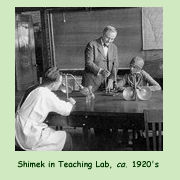 Shimek
was an indefatigable collector and he travelled extensively in North America,
as well as spending a year in Czechoslovakia. Conard (1945-46) noted that Shimek
had been in all but nine states of the United States, and in every county in
Iowa, by foot, horse, railroad, and eventually, automobile. Early in his career,
Shimek participated in an expedition to Nicaragua, where he spent three months
Shimek
was an indefatigable collector and he travelled extensively in North America,
as well as spending a year in Czechoslovakia. Conard (1945-46) noted that Shimek
had been in all but nine states of the United States, and in every county in
Iowa, by foot, horse, railroad, and eventually, automobile. Early in his career,
Shimek participated in an expedition to Nicaragua, where he spent three months
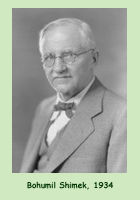 early
in 1893 (Shimek 1893). In his account of that trip, Shimek (1893) related that
he collected mainly vascular plants, as well as numerous specimens of mosses,
lichens, fungi, slime molds, beetles, mollusks, and even some snakes, lizards,
scorpions, ticks and ants. Approximately 15,000 plant specimens were collected
on that trip, according to Conard (1945-46). Herbarium records document that,
between 1925 and 1928, Shimek collected more than 10,000 specimens in Iowa,
Nebraska, South Dakota, Wisconsin and Illinois. It has been estimated that,
over his lifetime, Shimek contributed 200,000 specimens of vascular plants and
5,000 specimens of bryophytes to the collection (Conard 1945-46).
early
in 1893 (Shimek 1893). In his account of that trip, Shimek (1893) related that
he collected mainly vascular plants, as well as numerous specimens of mosses,
lichens, fungi, slime molds, beetles, mollusks, and even some snakes, lizards,
scorpions, ticks and ants. Approximately 15,000 plant specimens were collected
on that trip, according to Conard (1945-46). Herbarium records document that,
between 1925 and 1928, Shimek collected more than 10,000 specimens in Iowa,
Nebraska, South Dakota, Wisconsin and Illinois. It has been estimated that,
over his lifetime, Shimek contributed 200,000 specimens of vascular plants and
5,000 specimens of bryophytes to the collection (Conard 1945-46).
The taxonomic and geographic breadth of the collection developed by Macbride
and Shimek is reflected in the following description of the Herbarium in the
1902-03 University Catalogue:
|
"HERBARIUM
|
| The
herbarium is located in two rooms on the second floor of the Hall of Science
[presently Calvin Hall]. It contains: 1. A very large and constantly increasing collection of fungi, both parasitic and saprophytic, from all parts of North and Central America. To be classed here is also a large collection of the myxomycetes from all parts of the world. 2. A large collection of ferns and mosses from both hemispheres, including an especially complete series from tropical America. 3. A collection of lichens, representing most of the species of the United States. 4. A collection of many thousand flowering plants, representing very fully the flora of North America, and especially rich in Central American and European forms. The number of plants in the herbarium exceeds 200,000. 5. A collection of seeds and dry fruits, including cones, representing the flora of North America chiefly but containing also much material from the tropics. 6. A collection of the principal woods of the United States. 7. A collection of economic plant products, including plant fibers, materia medica, etc. The herbarium collections, thanks to friends and collectors in various parts of the world, are steadily increasing in extent and value. It is hoped that private collectors will hereafter as heretofore find the University a proper place for the deposit and care of collections of plants. Botanical field work has been conducted by representatives in the department in various parts of the state and country. During the past year work has been directed to the collection of the State flora chiefly, with special reference to matters of distribution. Excursions have also been made to California, Mexico, and Arizona. Special thanks for herbarium material are due to J.M. Holzinger, J.E. Cameron, Hattie M. Clearman, Lucy M. Cavanagh, C.W. Irish, Fred Reppert, L.H. Pammel, A.F. Ewers, R.I. Cratty, Maud Brown, Harold Wingate, H.M. Ivins, F.J. Seaver, C.I. Lambert. A constantly increasing library of systematic botanical literature is available to students carrying on special investigations in the herbarium." |
Perhaps Shimek's most significant scholarly scientific contribution was to establish,
in a series of papers (Shimek 1890, 1896, 1898), that wind, not water, was responsible
for the deposition of loess in eastern and western Iowa. This conclusion was
based on his analyses of fossil molluscs collected in loess deposits, and identified
by comparison to "many thousands of modern specimens" in his private
collection (Shimek 1898). His conclusions rested on his knowledge of the habitats
of extant snail species and the assumption that fossils of the same species
would have occupied similar habitats. Conard (1945-46) noted that, after his
death, Shimek's shell collection, comprised of 2,400,000 specimens, about half
of which are loess fossils, was sold to the Smithsonian Institution, according
to his wish. In a letter of December 4, 1945, the Smithsonian Curator of Mollusks
and Cenozoic Invertebrates described Shimek's collection as "the finest
gathering that has ever been brought together in that field anywhere in the
world" (Conard 1945-46).
Lucy
M. Cavanagh (1871-1936) became Herbarium Assistant in Botany in 1907
and Assistant Curator of the Herbarium in 1911 and continued in that position
until her death. She received a B.S. from the University of Iowa in 1896 and
taught school in Iowa City, both while working on her degree and for several
years after it was conferred (Paris 1937). In 1912, Macbride noted that "In
the herbarium of the University the work of Professor Shimek and Miss Cavanagh
has been most effective" (Macbride 1912). Cavanagh was particularly interested
in bryophytes and published a number of papers on the bryoflora of Iowa, based
on her own and Shimek's specimens.
 George
W. Martin (1886-1971) came to the University of Iowa in 1923,
having completed an M.S. on plant pathogens at Rutgers and a Ph.D. on organisms
involved in the food chain of oysters at the University of Chicago (Wells &
Lentz 1973). Once at Iowa, he began working on slime molds and fungi with Macbride.
Via a paper published in 1932, Martin was an influential advocate of the theory
that fungi and slime molds are a separate evolutionary line, independent of
both plants and animals (Wells & Lentz 1973). Many of his numerous publications
were taxonomic in nature. He co-authored the third revision of Macbride's treatment
George
W. Martin (1886-1971) came to the University of Iowa in 1923,
having completed an M.S. on plant pathogens at Rutgers and a Ph.D. on organisms
involved in the food chain of oysters at the University of Chicago (Wells &
Lentz 1973). Once at Iowa, he began working on slime molds and fungi with Macbride.
Via a paper published in 1932, Martin was an influential advocate of the theory
that fungi and slime molds are a separate evolutionary line, independent of
both plants and animals (Wells & Lentz 1973). Many of his numerous publications
were taxonomic in nature. He co-authored the third revision of Macbride's treatment
 of
North American slime molds, The Myxomycetes (Macbride & Martin 1934), and later
independently published a taxonomic treatment that was the standard reference
from 1949 (the year it was published) to 1969 (Wells & Lentz 1973). Still later,
he co-authored The Myxomycetes (Martin & Alexopoulos 1969), which was a world-wide
treatment of slime molds. With respect to collections, Wells and Lentz (1973)
noted that Martin was "an avid and skillful collector", and the Herbarium mycological
collection "must certainly be ranked among the very best", with "Most of these
collections…made and processed by Professor Martin".
of
North American slime molds, The Myxomycetes (Macbride & Martin 1934), and later
independently published a taxonomic treatment that was the standard reference
from 1949 (the year it was published) to 1969 (Wells & Lentz 1973). Still later,
he co-authored The Myxomycetes (Martin & Alexopoulos 1969), which was a world-wide
treatment of slime molds. With respect to collections, Wells and Lentz (1973)
noted that Martin was "an avid and skillful collector", and the Herbarium mycological
collection "must certainly be ranked among the very best", with "Most of these
collections…made and processed by Professor Martin".
 William
A. Anderson (1900-1949) came to the University of Iowa in 1931
and took over primary responsibility for the collections of vascular plants.
In 1940, he compiled Shimek's notes on early Herbarium acquisitions. Between
1938 and his untimely death in 1949, an average of 1,000 specimens were inserted
in the Herbarium each year. And in 1948, though terminally ill, Anderson oversaw
transfer of the flowering plant collections from old wooden cases to standard,
steel herbarium cases (Thorne 1951).
William
A. Anderson (1900-1949) came to the University of Iowa in 1931
and took over primary responsibility for the collections of vascular plants.
In 1940, he compiled Shimek's notes on early Herbarium acquisitions. Between
1938 and his untimely death in 1949, an average of 1,000 specimens were inserted
in the Herbarium each year. And in 1948, though terminally ill, Anderson oversaw
transfer of the flowering plant collections from old wooden cases to standard,
steel herbarium cases (Thorne 1951).
The paleobotanical collection was augmented in the 1930s through the efforts
of Fred Thompson, a businessman and collector
of Coal Age plant fossils from Illinois and Iowa. His specimens include Mazon
Creek nodules from central Illinois and coal balls from near Des Moines, Iowa.
Some of the material was sent to William Darrah at Harvard, and specimens also
were deposited in the University of Iowa Herbairum.
 After
Henry S. Conard (1874-1971)
retired from Grinnell College in 1944, he spent the next ten years at the University
of Iowa as a Visiting Research Professor in Botany (Welch & LeBlanc 1972). He
devoted his time to working in the Herbarium sorting,
After
Henry S. Conard (1874-1971)
retired from Grinnell College in 1944, he spent the next ten years at the University
of Iowa as a Visiting Research Professor in Botany (Welch & LeBlanc 1972). He
devoted his time to working in the Herbarium sorting,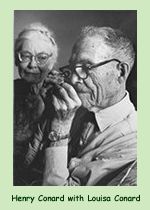 identifying (in some cases), and curating Shimek's thousands of collections
of Iowa vascular plants and bryophytes. Conard also incorporated his own collections
of mosses (ca. 25,000 specimens) and hepatics (ca. 5,000 specimens) into the
Herbarium. During Conard's tenure at the University of Iowa, the entire bryophyte
collection of Iowa State University (ca. 2-3,000 specimens) was transferred
on permanent loan to IA (Thorne 1956). In 1956, Thorne estimated that there
were 37,000 bryophyte collections in the Herbarium (Thorne 1956). While at the
University of Iowa, Conard also prepared a manuscript, "Notes for a Biography
of Bohumil Shimek" (Conard 1945-46).
identifying (in some cases), and curating Shimek's thousands of collections
of Iowa vascular plants and bryophytes. Conard also incorporated his own collections
of mosses (ca. 25,000 specimens) and hepatics (ca. 5,000 specimens) into the
Herbarium. During Conard's tenure at the University of Iowa, the entire bryophyte
collection of Iowa State University (ca. 2-3,000 specimens) was transferred
on permanent loan to IA (Thorne 1956). In 1956, Thorne estimated that there
were 37,000 bryophyte collections in the Herbarium (Thorne 1956). While at the
University of Iowa, Conard also prepared a manuscript, "Notes for a Biography
of Bohumil Shimek" (Conard 1945-46).
 In
1950, Robert
F. Thorne succeeded Anderson as Curator of Vascular Plants, and
initiated a period of intense activity in the Herbarium. Upon his arrival, Thorne
immediately undertook an extensive floristic analysis of Iowa. He divided the
state up into eight sections (corresponding to the major
In
1950, Robert
F. Thorne succeeded Anderson as Curator of Vascular Plants, and
initiated a period of intense activity in the Herbarium. Upon his arrival, Thorne
immediately undertook an extensive floristic analysis of Iowa. He divided the
state up into eight sections (corresponding to the major landform regions) and assigned seven students to study one region each (the
eighth region was covered by a student at Iowa State University). The collections
that resulted from Thorne's research and that of his students (T. van Bruggen,
J. Carter, T. S. Cooperrider, R. A. Davidson, L. J. Eilers, M. Fay, and T. G.
Hartley), plus material received through an active exchange program, were inserted
into the herbarium at a rate of
landform regions) and assigned seven students to study one region each (the
eighth region was covered by a student at Iowa State University). The collections
that resulted from Thorne's research and that of his students (T. van Bruggen,
J. Carter, T. S. Cooperrider, R. A. Davidson, L. J. Eilers, M. Fay, and T. G.
Hartley), plus material received through an active exchange program, were inserted
into the herbarium at a rate of  approximately
4,000 specimens per year (Thorne 1951). In 1951, Thorne estimated that there
were 81,000 vascular plants, 50,000 fungi (including myxomycetes), 11,000 bryophytes
and 1,000 algae in the Herbarium, and he noted that Iowa specimens constituted
approximately one third
approximately
4,000 specimens per year (Thorne 1951). In 1951, Thorne estimated that there
were 81,000 vascular plants, 50,000 fungi (including myxomycetes), 11,000 bryophytes
and 1,000 algae in the Herbarium, and he noted that Iowa specimens constituted
approximately one third 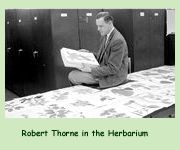 of
the holdings of vascular plants. By the time Thorne left for Rancho Santa Ana
Botanical Garden in 1962, he and his students had added approximately 27,000
specimens of vascular plants to the collection.
of
the holdings of vascular plants. By the time Thorne left for Rancho Santa Ana
Botanical Garden in 1962, he and his students had added approximately 27,000
specimens of vascular plants to the collection.
In the 1960s, Donald Eggert curated the paleobotanical
collections in the Herbarium. His research focused on coal balls, mostly from
Illinois, and he took these collections with him when he left the University.
Jeffry Schabilion succeeded Eggert as Paleobotanical
Curator in the late 60s, and the primary focus of his research has been coal
balls from central Iowa mines, and impression/compression specimens also from
Iowa.
From 1963 to 1981, Thomas Melchert and Robert
L. Hulbary (1916-1981) curated the vascular plant collections,
and Hulbary also was in charge of the bryophyte collections. In the period from
1970 to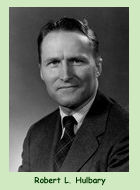 1980, extensive holdings of lichens and myxomycetes were disposed of. Between
five and 8,000 specimens of lichens collected by Shimek were transferred first
to the U.S. National Herbarium at the Smithsonian Institution in Washington,
D.C. and subsequently to the University of Minnesota Herbarium in the early
70s. In 1977, George Martin's myxomycete collections (approximately 8500 specimens)
were transferred on permanent loan to the U.S. National Fungus Collections Herbarium
in Beltsville, Maryland.
1980, extensive holdings of lichens and myxomycetes were disposed of. Between
five and 8,000 specimens of lichens collected by Shimek were transferred first
to the U.S. National Herbarium at the Smithsonian Institution in Washington,
D.C. and subsequently to the University of Minnesota Herbarium in the early
70s. In 1977, George Martin's myxomycete collections (approximately 8500 specimens)
were transferred on permanent loan to the U.S. National Fungus Collections Herbarium
in Beltsville, Maryland.
After Hulbary's untimely death in 1981, Diana Horton
came to the University of Iowa in 1983 and assumed responsibility as Director
of the Herbarium and Curator of Vascular Plants and Bryophytes.
In 1984, it was decided to narrow the focus of the collections to vascular plants,
bryophytes and fossil plants, so that limited space and resources could be devoted
to areas of collection strength and faculty interest. Approximately 20,000 specimens
of fungi, mainly, and also the remaining myxomycete collections, were transferred
to Iowa State University on permanent loan in 1984. More recently (1989), approximately
1,500-2,000 specimens of aquatic algae and corals also were transferred to Iowa
State University on permanent loan. In late 1989, the College of Liberal Arts
provided funding for a half-time position for curatorial assistance, a position
filled by Jennifer Bell until she moved to the state of Washington in 1998.
Subsequently, Paula Bergstrom became Assistant Curator and continued in the
position until December, 2003.
Calvin, S. 1908. Professor
Macbride as a Man, pp. 6-8. In: Anonymous, Thirty Years in the State University.
A Tribute to Thomas Huston Macbride. Privately Printed for the Subscribers to
the Fund. 1-9 pp.
Conard, H.S. 1945-46. Notes for a Biography of Bohumil Shimek. Manuscript, University
of Iowa. 76 pp.
__________. (ed.) 1948. The plant geography of Iowa by B. Shimek. Univ. of Iowa
Studies Nat. Hist. 18: 178.
Conklin, M.W. 1945. The History of the State University of Iowa: Thomas Huston
Macbride. M.A. Thesis, Department of History, State University of Iowa, Iowa
City, IA. 119 pp.
Conklin Schertz, M.W.C. & W.L. Myers. 1947. Thomas Huston Macbride. University
of Iowa Press,
Iowa City. 77 pp.
Hartwig, N.L. 1976. An Anatomical Study of Cycadeoidea dacotensis and
Cycadeoidea mcbridei. Ph.D. Thesis, University of Iowa, Iowa City, Iowa.
131 pp.
Holzinger, J.M. 1904-1929. Musci Acrocarpi Boreali-Americani. Distributed by
John M. Holzinger. Fascicles I-XXVII, numbers 1-675. Winona, Minnesota.
Kay, G.F. 1939. Memorial to Bohumil Shimek. Proc. Geol. Soc. Am. for 1938: 169-170.
Loehwing, W.F. 1937. Bohumil Shimek. Science 85: 306-307.
Loehwing, W.F. 1947. Bohumik Shimek. University of Iowa Press, Iowa City. 36
pp.
Macbride, T.H. 1912. Twenty-five years of botany in Iowa. Iowa Acad. Sci. 19:
43-63.
__________. 1896a. A pre-kansan peat bed. Proc. Iowa Acad. Sci. 4: 63-66.
__________. 1896b (1895). County parks. Proc. Iowa Acad. Sci. 3: 91-95.
__________. 1898 (1897). The President's address. Proc. Iowa Acad. Sci. 5: 12-23.
Martin, G.W. 1932. Systematic position of the slime molds and its bearing on
the classification of the fungi. Bot. Baz. 93: 421-435.
M'Bride, T.H. 1894. North American cycads. Proc. Iowa Acad. Sci. 1: 62-65.
Monson, P.H. 1959. Spermatophytes of the Des Moines Lobe in Iowa. Ph.D. Iowa
State University, Ames. 353 pp.
Paris, C.D. 1937. Lucy M. Cavanagh 1871-1936. Proc. Iowa Acad. Sci. 44: 23-24.
Pickard, J.L. 1899. Historical Sketch of the State University of Iowa. Iowa
City, IA.
Raventon, E. 1994. "Island in the Plains" A Black Hills Natural History. Johnson
Printing Company, Boulder, Colorado.
Roosa, D.M. 1981. Iowa natural heritage preservation: history, present status,
and future challenges. Proc. Iowa Acad. Sci. 88: 43-47.
Sayre, G. 1969. Cryptogamae Exsiccatae -- an annotated bibliography of published
exsiccatae of
Algae, Lichenes, Hepaticae and Musci. Mem. New York Bot. Gard. 19: 1-174.
Schrimper, G.D. 1992. The University of Iowa Museum of Natural History an historical
perspective.
J. Iowa Acad. Sci. 99: 86-97.
Semken, H.A. & G.D. Schrimper. 1978. Museum of Natural History, The University
of Iowa. ASC Newsletter 6(4): 37-42.
Shimek, B. 1890. The loess and its fossils. Bull. Lab Nat. Hist. State Univ.
Iowa 1: 200-214.
__________. 1893. A botanical expedition to Nicaragua. Bull. Lab. Nat. Hist.
State Univ. Iowa
2:345-376.
__________. 1896 (1895). A theory of the loess. Proc. Iowa Acad. Sci. 3: 82-89.
__________. 1898 (1897). Is the loess of aqueous origin. Proc. Iowa Acad. Sci.
5: 32-45.
__________. 1934. Thomas Huston Macbride. Mycologia 26: 378-383.
Thorne, R.F. 1956. Herbarium Report (unpublished).
__________. 1951.
Herbarium of the State University of Iowa. Iowa Acad. Sci. 58:215-219.
Welch, W.H. & F. LeBlanc. 1972. Henry S. Conard (1874?1971). Bryologist 75:
558-565.
Wells, K. & P.L. Lentz. 1973. George Willard Martin (1886-1971). Mycologia 65:
985-998.
Zieglowsky, D.J. 1985. Thomas Macbride's Dream: Iowa Lakeside Laboratory. Palimpsest
66: 42-65.
Last Updated: 03/21/2006